ASRock ConRoe945G-DVI: Core 2 Duo goes mATX
by Gary Key on September 1, 2006 5:15 AM EST- Posted in
- Motherboards
Features and Layout
ASRock designed a very well laid out board with all major connections easily reached. The layout provides very good clearance for cards and components while being very simple to install in our mid-size ATX case or mATX case. The board features a 4-phase voltage regulator power design that provided very good stability during general usage and light overclocking.
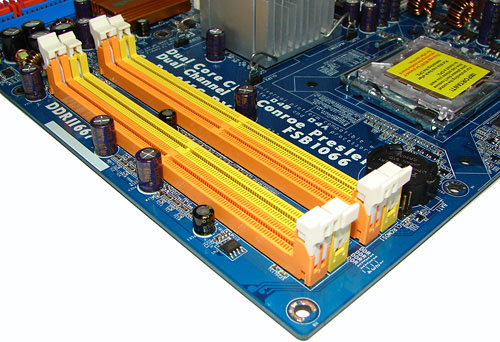
The DIMM module slots' color coordination is correct for dual channel setup. The memory modules are easy to install with a full size video card placed in the PCI Express X16 slot. The battery and clear CMOS jumper are located at the right edge of the number one DIMM slot.
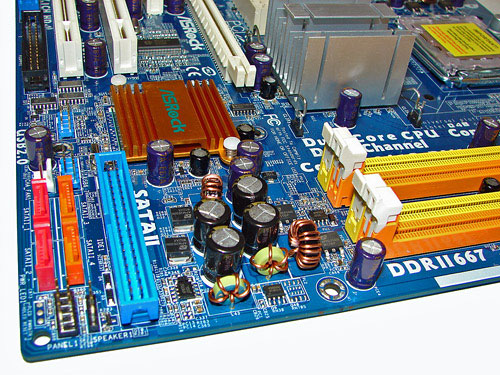
The orange and pink Intel ICH7 SATA ports are conveniently located on the board's left edge and next to the blue IDE port connector. Unlike other recently reviewed boards the SATA ports are color coded for primary and secondary operation if this is important to you. We found the positioning of the SATA ports to be excellent when utilizing the PCI slots or the single IDE port connector. The Intel ICH7 chipset is passively cooled with a low-rise heat sink.
The blue IDE did not present any connection issues in our mid-size ATX case or SFF test case. The location of this connector is very good for most cases and those users still utilizing IDE hard drives. The chassis panel and system fan header are located on the left edge of the board near the SATA ports. The two USB 2.0 headers are located to the left of the Intel ICH7.
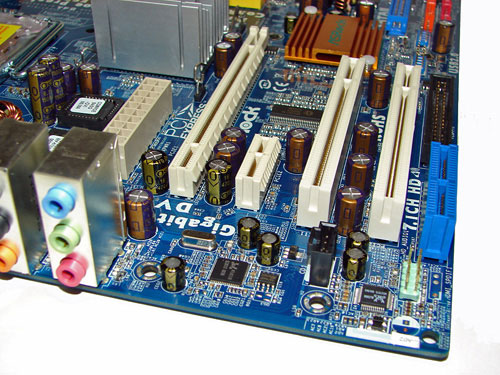
The board comes with one physical PCI Express X16 connector, one PCI Express X1 connector, one HDMR slot, and two PCI 2.3 compliant 32-bit connectors. The layout of this design offers a good balance of expansion slots for a mATX board.
The 20-pin ATX power connector is located in an unusual position in front of the large passive heat sink for the Intel 945G MCH. The PCI Express X16 connector is located next followed by the single X1 PCI Express connector. The location of this PCI Express X1 connector allows installation of most peripheral PCI Express cards and is only blocked by most dual slot video card designs.
The two PCI connectors are located next and followed by the HDMR slot. The black floppy drive connector is located in an inconvenient position behind the HDMR slot. The front audio panel header is located in front of the HDMR slot.
Returning to the CPU socket area, we find an ample amount of room for alternative cooling solutions. We utilized the stock Intel heat sink but also verified our Tuniq 120 Tower and Scythe Infinity would fit in this area during our tests, although we doubt most users of the this board would go to that extreme to cool the processor.
The Intel 945G chipset is passively cooled with a large heat sink that did not interfere with any installed peripherals. Our only concern is the location of the 20-pin ATX power connector as the cabling tends to interfere with the CPU heat sink/fan during usage. ASRock places the four-pin ATX power connector at the top of the CPU socket area and next to the CPU fan header.
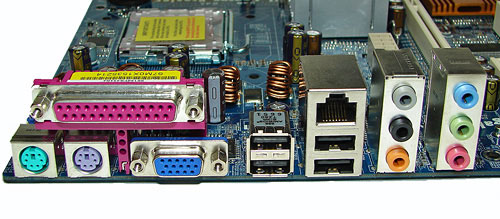
The PS/2 mouse and keyboard ports are located on the bottom of the I/O panel and underneath the LPT parallel port. The VGA port is located to the left of the first two USB ports and below the LPT parallel port. The LAN (RJ-45) port and the second pair of USB 2.0 connectors are located next to the first set of USB ports. The audio panel consists of 6 ports that can be configured for 2, 4, 6, and 8-channel audio connections.
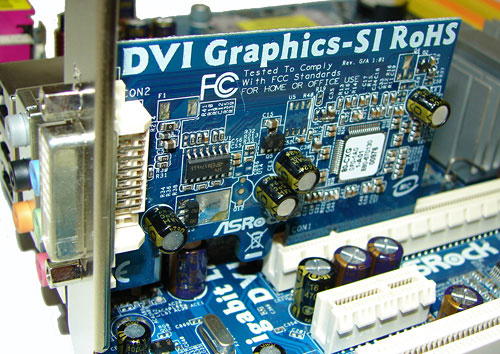
ASRock ships a DVI accessory card that installs into the PCI-Express X16 slot and offers dual monitor capability when utilized with the onboard Intel 950GMA solution. In our testing, this capability worked well with general office applications such as Word or Excel.
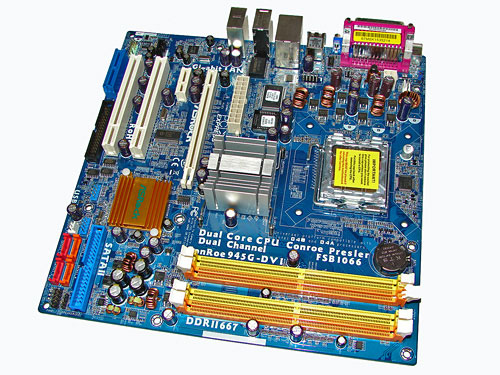 |
| Click to enlarge |
ASRock designed a very well laid out board with all major connections easily reached. The layout provides very good clearance for cards and components while being very simple to install in our mid-size ATX case or mATX case. The board features a 4-phase voltage regulator power design that provided very good stability during general usage and light overclocking.

The DIMM module slots' color coordination is correct for dual channel setup. The memory modules are easy to install with a full size video card placed in the PCI Express X16 slot. The battery and clear CMOS jumper are located at the right edge of the number one DIMM slot.

The orange and pink Intel ICH7 SATA ports are conveniently located on the board's left edge and next to the blue IDE port connector. Unlike other recently reviewed boards the SATA ports are color coded for primary and secondary operation if this is important to you. We found the positioning of the SATA ports to be excellent when utilizing the PCI slots or the single IDE port connector. The Intel ICH7 chipset is passively cooled with a low-rise heat sink.
The blue IDE did not present any connection issues in our mid-size ATX case or SFF test case. The location of this connector is very good for most cases and those users still utilizing IDE hard drives. The chassis panel and system fan header are located on the left edge of the board near the SATA ports. The two USB 2.0 headers are located to the left of the Intel ICH7.

The board comes with one physical PCI Express X16 connector, one PCI Express X1 connector, one HDMR slot, and two PCI 2.3 compliant 32-bit connectors. The layout of this design offers a good balance of expansion slots for a mATX board.
The 20-pin ATX power connector is located in an unusual position in front of the large passive heat sink for the Intel 945G MCH. The PCI Express X16 connector is located next followed by the single X1 PCI Express connector. The location of this PCI Express X1 connector allows installation of most peripheral PCI Express cards and is only blocked by most dual slot video card designs.
The two PCI connectors are located next and followed by the HDMR slot. The black floppy drive connector is located in an inconvenient position behind the HDMR slot. The front audio panel header is located in front of the HDMR slot.
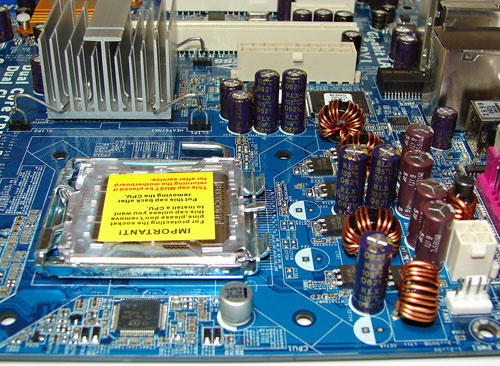 |
| Click to enlarge |
Returning to the CPU socket area, we find an ample amount of room for alternative cooling solutions. We utilized the stock Intel heat sink but also verified our Tuniq 120 Tower and Scythe Infinity would fit in this area during our tests, although we doubt most users of the this board would go to that extreme to cool the processor.
The Intel 945G chipset is passively cooled with a large heat sink that did not interfere with any installed peripherals. Our only concern is the location of the 20-pin ATX power connector as the cabling tends to interfere with the CPU heat sink/fan during usage. ASRock places the four-pin ATX power connector at the top of the CPU socket area and next to the CPU fan header.

The PS/2 mouse and keyboard ports are located on the bottom of the I/O panel and underneath the LPT parallel port. The VGA port is located to the left of the first two USB ports and below the LPT parallel port. The LAN (RJ-45) port and the second pair of USB 2.0 connectors are located next to the first set of USB ports. The audio panel consists of 6 ports that can be configured for 2, 4, 6, and 8-channel audio connections.

ASRock ships a DVI accessory card that installs into the PCI-Express X16 slot and offers dual monitor capability when utilized with the onboard Intel 950GMA solution. In our testing, this capability worked well with general office applications such as Word or Excel.










33 Comments
View All Comments
Gary Key - Friday, September 1, 2006 - link
We will go in-depth with power consumption and cooling opportunities in the upcoming mATX review that will include AM2 boards as well.esterhasz - Saturday, September 2, 2006 - link
great! can't wait!mino - Friday, September 1, 2006 - link
LOL, just posted a request for that down under, must learn to read :)Please try to include that K9AGM I asked for, or at least other RS485/SB600 combo board.
Consider the fact K9AGM is a part of the AMD CSIP program so this board is gonna bea round at least until Q4'07. It's not your average seasonal thing like most are.